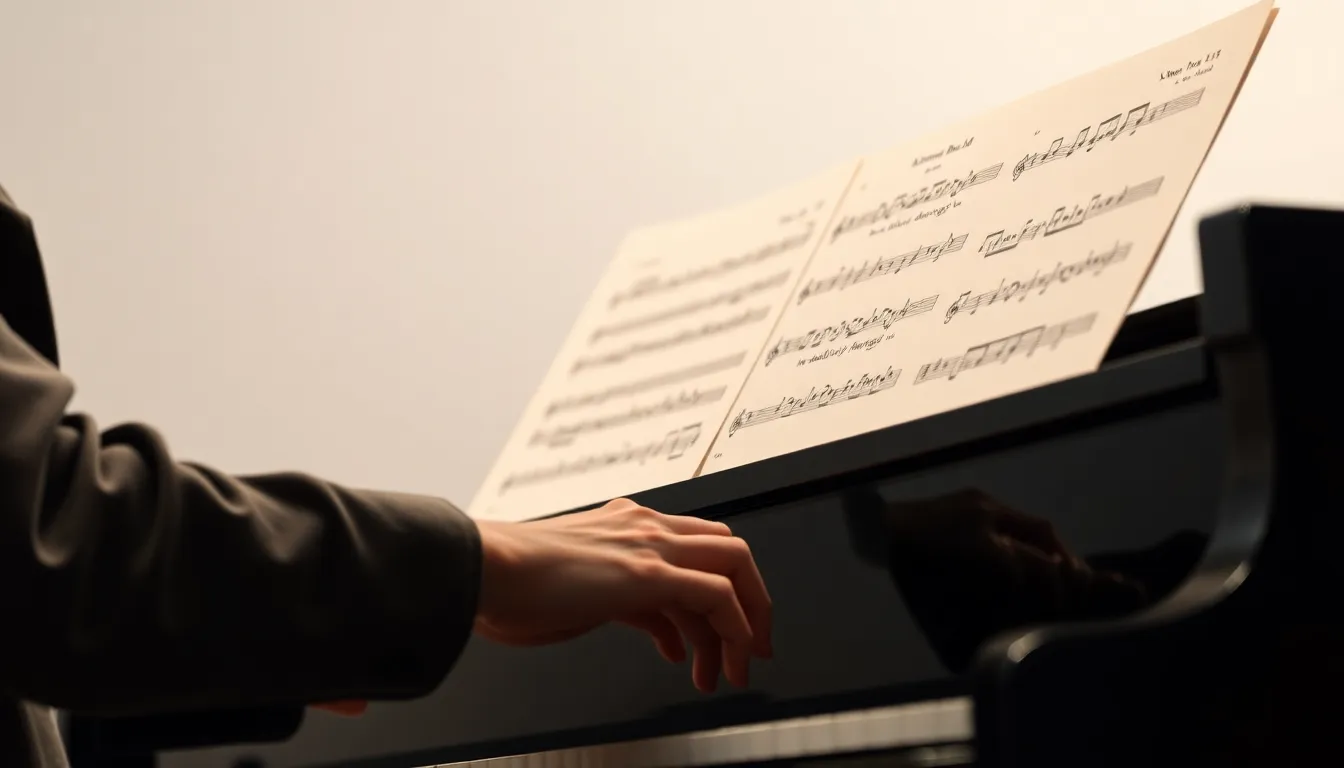In a world overflowing with noise and chaos, minimalist classical music offers a refreshing escape. Imagine a symphony stripped down to its essence, where every note breathes and resonates with purpose. It’s like decluttering your mind while sipping a fine cup of tea—sophisticated yet surprisingly comforting.
This genre invites listeners to experience beauty in simplicity, proving that less is often more. Think of it as the elegant little black dress of the music world—timeless and versatile. Whether you’re working, meditating, or just trying to find your zen, minimalist classical sets the perfect backdrop. So, why not turn down the volume on life’s distractions and tune into the serene sounds that can elevate any moment? Embrace the calm and let the music carry you away.
Table of Contents
ToggleOverview of Minimalist Classical
Minimalist classical music offers a refined and purposeful auditory experience, providing an escape from life’s chaos. This genre emphasizes simplicity and elegance, enhancing tranquility during various activities.
Definition and Origins
Minimalist classical music emerged in the mid-20th century, primarily in the United States. Composers such as Steve Reich, Philip Glass, and Terry Riley played pivotal roles in its development. Originating as a reaction against complexity in modernist music, it focuses on repetition, gradual transformation, and tonal harmony. This movement reflects a shift towards accessible forms, making music more relatable and engaging for listeners. The roots of minimalist classical can be found in earlier genres like minimalism in visual arts and literature, establishing a deeper connection across artistic expressions.
Key Characteristics
Minimalist classical music is defined by specific characteristics that distinguish it from other genres. Repetition stands at the forefront, allowing listeners to immerse themselves in the sound. Gradual change plays a crucial role, with musical phrases evolving subtly over time. Harmony often remains tonal, creating a sense of stability and comfort. Instruments typically include strings, pianos, and woodwinds, contributing to the genre’s delicate texture. Additionally, space between notes offers moments of reflection, inviting a meditative experience. These features collectively enhance minimalist classical music’s appeal, making it a versatile choice for various settings.
Influential Composers

Minimalist classical music has seen significant contributions from several composers. Notable figures like Steve Reich and Philip Glass played pivotal roles in shaping this genre’s distinctive sound.
Steve Reich
Steve Reich is known for his innovative approach to rhythm and texture. His works often use phasing, a technique where two identical phrases gradually shift out of sync. “Music for 18 Musicians,” one of his most celebrated compositions, exemplifies this method, creating intricate patterns that mesmerize listeners. Reich’s influences include traditional African drumming and Balinese gamelan, which inspire his rhythmic complexity. His techniques invite audiences into a hypnotic musical experience, emphasizing simplicity while crafting a rich sonic landscape.
Philip Glass
Philip Glass stands out for his unique minimalist style that combines melody and harmony. His compositions frequently feature repetitive structures that develop gradually, providing a sense of evolving narrative. “Einstein on the Beach” showcases Glass’s operatic approach, blending spoken word with music in a groundbreaking way. His film scores, including “The Hours,” highlight his ability to evoke emotion through sparse yet impactful melodies. Glass’s contributions not only define minimalist classical music but also influence numerous contemporary artists across various genres.
Notable Works in Minimalist Classical
Minimalist classical music boasts a variety of influential compositions that exemplify its distinctive qualities. These works invite listeners into a serene and introspective auditory world.
Major Compositions
Steve Reich’s “Music for 18 Musicians” remains a seminal work within the genre. This composition, with its intricate rhythms and phasing patterns, captivates audiences. Philip Glass’s “Einstein on the Beach” offers a unique operatic experience, blending music and theater fluidly. Terry Riley’s “In C” introduces a playful and accessible approach to minimalism, emphasizing improvisation. Each of these compositions serves as a hallmark of minimalist classical music, showcasing its ability to evoke emotional depth through simplicity.
Analysis of Key Pieces
“Music for 18 Musicians” displays Reich’s characteristic phasing technique, gradually transforming musical patterns. This method creates a rich, evolving texture that draws listeners in. “Einstein on the Beach,” notable for its lack of a traditional narrative, instead uses repetitive musical motifs to enhance the emotional impact. It blends operatic elements with minimalist soundscapes. In “In C,” Riley’s use of open-ended structures encourages musicians’ creativity while maintaining unity. These pieces collectively highlight the essential traits defining minimalist classical music, including repetition and gradual evolution.
Impact on Modern Music
Minimalist classical music affects various facets of contemporary music today. Its influence resonates through diverse genres and inspires a new generation of composers.
Influence on Contemporary Composers
Contemporary composers draw inspiration from minimalist principles. They often incorporate repetition and gradual transformation, fostering immersive listening experiences. For example, Max Richter’s use of minimalism in his works exemplifies this influence. Additionally, composers like Ólafur Arnalds blend minimalism with electronic elements. The simplicity found in their music echoes the essence of traditional minimalism, showcasing its lasting impact.
Cross-Genre Applications
Minimalist classical music transcends its origin, permeating various genres. In film, its evocative soundscapes enhance emotional depth, found in scores like those of Hans Zimmer. Beyond film, pop artists, such as Brian Eno, utilize minimalist techniques to create atmospheric sound. Even within the realm of electronic music, the influence is palpable, with artists embracing repetitive structures. These cross-genre applications demonstrate minimalist classical music’s versatility and enduring relevance.
Minimalist classical music offers a serene refuge from the noise of daily life. Its emphasis on simplicity and repetition invites listeners to engage deeply with each note while fostering a sense of calm. The genre’s evolution reflects a profound connection to both tradition and modernity, showcasing its adaptability in various contexts.
As contemporary artists continue to draw inspiration from minimalist principles, its influence remains strong across genres. This enduring appeal highlights the power of minimalist classical music to enhance moments of reflection and creativity, making it a valuable addition to anyone’s auditory experience. Embracing this genre can lead to a more tranquil and focused mindset, enriching life’s many activities.


